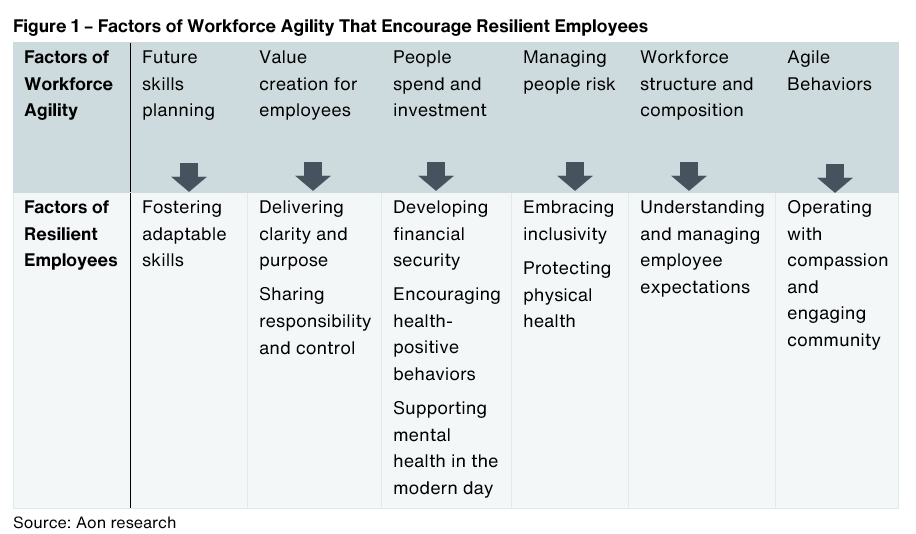Workforce agility and resiliency are complimentary traits within the workforce and of exceeding importance given the rise in long tail and unpredictable risks. Our experience in working with organizations has found that workforce agility is an enabler for employees to feel and act more resilient.
Workforce agility and employee resilience are critical to helping organizations and their employees survive and thrive in an age where risks, volatility and disruption are part of everyday life. Agility and resilience should be measured, fostered and improved upon — but the complimentary nature of each and how one outcome can shape the other is an underexplored area for business and HR leaders. With only 30 percent of employees identifying as resilient[1], there is untapped potential for organizations to influence the way people show up and feel about their work.
Defining agility and resilience
Resilient employees have the ability to weather a storm, adapt to adverse situations, manage stress and retain motivation. Agility enables employees to quickly move into new roles or develop new skills to support changing business needs.
The benefits of having an agile and resilient workforce are compelling. Ninety-three percent of employees that identify as resilient say they want to stay with their employer and 86 percent feel fully motivated at work1. What’s more, building an agile and resilient workforce will engage employees and keep them with the business. And new analysis from Aon’s human capital business has found that employee tenure is correlated with higher productivity.
To truly optimize workforce performance, an organization needs to align around both of these attributes.
Getting to a more agile and resilient workforce
Certain talent management processes and total rewards programs have a measurable influence on agility and resilience. Aon has conducted extensive research over the past two years into which of these programs have the biggest impact. In our article “To Build Workforce Agility, Look at These Six Factors,” we explored the six factors that influence workforce agility.
When it comes to fostering resilient employees, research from our Rising Resilient report finds 10 factors that have the biggest influence.
When comparing these two sets of influencing factors it becomes clear where the influencing factors of workforce agility overlap and encourage the factors that influence resilient employees.

“People can get burned out because jobs are not designed to meet their skills and needs, or they are overworked,” says Marinus van Driel, human capital strategy lead at Aon. “If you change that at an organizational level — in other words, you enable workforce agility — that completely changes their individual performance,” he says. In other words, enacting workforce agility leads to resilient behaviors.
Examples of workforce agility leading to resilient employees
The factors that influence both agility and resilience are each individually important, but the emphasis organizations give to them will depend on each employer’s unique situation and workforce attributes. Additionally, certain factors may become more or less important at different points in time. For example, the coronavirus (COVID-19) pandemic brought mental health to the forefront as more people struggled with depression or feelings of isolation that may not have been an issue prior to the pandemic.
To explore further how workforce agility factors can lead to resilient employees, we highlight a couple of examples. Let’s start with managing people risk — one of six factors of workforce agility. Effectively managing people risk will ensure employees are protected and leads to better mental and physical health and overall wellbeing outcomes.
“Employees need their basic needs met before they can help a business grow,” van Driel says. “It’s the basic principle of protect people and you protect the business.”
Another factor that leads to workforce agility is future skills planning. This is an exercise of increasing importance as the skills needed to thrive in a digital, fast-paced environment are changing. (Learn more in our white paper, “Closing the Future Skills Gap to Drive Business Success.”) Organizations benefit from this effort through upskilling and reskilling current talent rather than relying solely on attracting new employees, which often costs more time and money. Meanwhile, individuals will be more resilient to weather change when they possess future-leading skills. By going through each of the workforce agility factors, we can see clear outcomes to the traits that define a resilient employee.
Next Steps
When an employer is successful at fostering an agile and resilient workforce, employees will have a fundamental sense of security at work, a strong feeling of belonging in their job, and the adaptability and motivation they need to reach their full potential. These traits lead to a healthier and happier workforce; they also are indicators of better talent management practices and outcomes. A happier workforce is a more loyal one, for example.
To measure how agile and resilient your workforce is, we invite you to take Aon’s complimentary self-assessments: